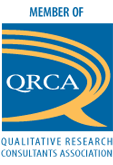Product Development
A Fortune 100 company needed to see what appeal a novel product concept held for customers. Before making a major technology investment to build the product they needed to assess the strength of the concept and exactly what benefits customers anticipated receiving from its use. The focus group design anticipated and successfully validated likely market segments. This study crystallized critical feature functionality that was then taken into a quantitative study to finalize the business requirements and size the market opportunity. The product launched successfully. Awareness, Attitudes and Usage research conducted a year after the launch confirmed that the benefits and critical feature functionality identified early on were what was driving sales and product satisfaction.
Customer Retention
A top ten national bank grew concerned over a steady, unacceptable rate of customer attrition. After failing to make major improvements through traditional communications and standard surveys we were asked to bring a fresh approach to solving the problem. We used “Laddering” (See Techniques for description of Laddering.) to uncover the Root Causes of the attrition and in a follow up study tested a Retention Protocol that when launched, resulted in 20% improvement in customer attrition.
Communications Testing
After extensive concept and new product work with this client we were retained to run a disaster check on their product brochure. Though it had been thoughtfully and creatively designed leveraging all past learnings the brochure failed. Customers failed to understand the product, not seeing it as unique or desirable. We dissected what was perceived, confirmed that the intended messages were impactful. We collaborated with the advertising agency and the client in between focus groups in different cities on new copy until we got it right. In the process we learned invaluable lessons regarding the competition between clarity and brevity in communications.
Product Usability
A large packaged goods company was developing a new trash bag with pull strings. Our client knew it had some structural weakness that had to be addressed but were constrained by cost. They could not afford to build maximum strength into every possible stress point. We were hired to determine how customers would really use the bags and which of the stress points had to be strengthened. One approach we considered was conducting an ethnographic study, placing the product in consumers’ homes and then recording how the bags were used and where they failed. This approach was rejected due to budget constraints and liability concerns. (Our client was concerned about damage caused by garbage dropping out of broken bags.) So, we used an experimental design and assembled hundreds of items typically thrown into kitchen garbage bag. Operating out of suburban malls, consumers were asked to select a trash container most like the one they used at home and then fill it as much or little as they typically do with the assembled items. We observed them as they removed the bag using the drawstrings however they chose and then walked down the hall to deposit it. By watching and recording what we saw, we found how the bags were actually used, facilitating cost effective re-engineering and a successful product launch.
Website User Interface Testing
A young technology firm built a novel subscription web product. We understood it was critical that customers find the site intuitive to use. Customers were not going to watch videos and read lengthy explanations on how it worked. Working with different versions of the Web Interface from Screenshots to a working Prototype, we introduced target customers to the product and observed them as they surfed the site. The insights we derived came from the combination of observations followed by probing discussion. This process was repeated until arriving at the right presentation where customers ‘got it,’ they understood the core product benefits, found it easy to access and were ready to enroll.

 QRCA is a not-for-profit association of consultants involved in the design and implementation of qualitative research — focus groups, in-depth interviews, in-context and observational research, and more.
QRCA is a not-for-profit association of consultants involved in the design and implementation of qualitative research — focus groups, in-depth interviews, in-context and observational research, and more.